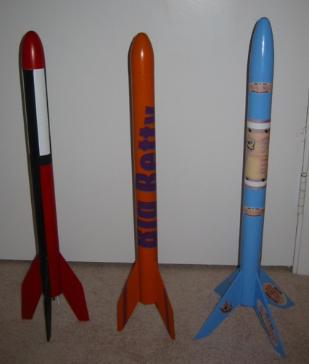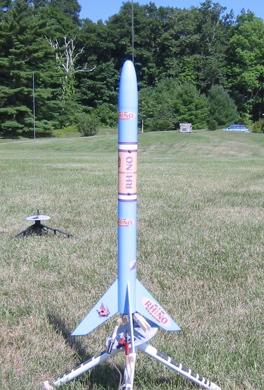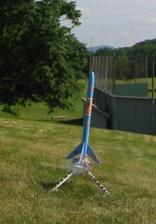| Construction Rating: | starstarstarstarstar |
| Flight Rating: | starstarstarstarstar_border |
| Overall Rating: | starstarstarstarstar_border |
| Diameter: | 1.64 inches |
| Length: | 24.50 inches |
| Manufacturer: | FlisKits  |
| Skill Level: | 1 |
| Style: | Sport |

Background:
This spring I ran a build session for faculty kids at the school where I teach. I ended up using the Quest Bright Hawk for the 7-9 year olds and the Quest Big Betty for the 10-12 year olds. After the build session, I began thinking about the types of rockets that would make great first builds for a budding rocketeer. I wanted to select rockets to compare that had the following in common:
- BT-60 body tube
- Parachute recovery
- Balsa fins
- Engine hook motor retention
- Reasonable Price
- Stable flight performance
- A rocket that can fly on small athletic fields and can be viewed in all aspects of flight. In other words, no Alphas, Wizards, or Vikings.
I ended up selecting 3 rockets that fit these criteria. The Estes Big Bertha, the Quest Big Betty, and the Fliskits Rhino.
Click Here for the Comparison Article.
 Construction:
Construction:
The Fliskits Rhino was really fun to put together. I found the quality of the parts better than the Estes and Quest counterparts. I liked the balsa nose cone, but this required an additional step of adding a screw eye as well as the need to prime and fill the balsa for getting a smooth finish. There is an engine hook and the centering rings fit the motor mount very well. What is really cool about the Rhino is that there are laser cut fins that come with additional fin templates. There are actually a two different designs that can be cut from the given fin design. I assume someone could actually use three different fins on the Rhino with success. The fins are very large and swept back, so the stability of the rocket is probably pretty good. I decided to keep things textbook and stay with the laser cut design. I simply rounded the edges and used the double glue method to attach the four fins to the body tube. I added fillets to the fins and then proceeded to add the launch lug. On the Rhino, one is instructed to add 2 launch lugs, so it is helpful to use a launch rod to make sure you have everything lined up. If you don't use a thin dowel or launch rod, you may have a bit of trouble getting the launch lugs to line up (and we all know there is nothing worse than getting out to the field with your new rocket and being unable to get the rocket on the pad due to misaligned lugs).
Finishing:
I primed and Fill-N-Finished the rocket. I painted the middle section white, then masked it off and painted the whole rocket a kind of baby blue like it appears on the cover art. If you want to add decals, you have to realize there are none in the kit. This is both good and bad. Bad, because it is nice to have an entire kit. Good, because you can go to www.fliskits.com and download a .pdf file of the original decals. You can then select your own type of paper (I used Avery sticky paper), and then produce your own decals. I felt more hands-on doing this, but this was probably the most difficult part of the build. If I was 10 years old, I would not have had the patience to cut out all the rhino heads and other designs. On the other hand, I felt more involved in the project like I was doing a scratch build. It also gives the builder the idea that they can design and print their own decals. I printed the Rhino decals on an ink jet printer, then coated the decals with clear enamel. After I cut out the designs, I placed the decals on the rocket, then gave the rocket a coat of Future Floor Polish. One of the cool decals on the Rhino is a little info plaque that can be added to the rocket. It gives the dimensions of the rocket as well as the recommended motors. I thought this was brilliant. The novice flyer can then take the rocket out to the field and know exactly what motor to use without having to guess.
Construction Rating: 5 out of 5
 Flight:
Flight:
The rocket is big enough to prep easily and pack the parachute. I flew this first on a B6-4 and was surprised how low the flight was. I then used a C6-5 on my next flight. The boost and flight was beautiful, but unfortunately, the rocket ended up in a tree. I usually criticize the tri-fold shock cord method (used on the Rhino and Estes kits), but this was the saving grace of the rocket. After a few days of rain and some wind, the body tube came loose from the shock cord and fell down to the ground. A few days after this, the nose cone and parachute blew loose from the tree. So, I now have recovered both parts of my rocket.
Flight Rating: 4 out of 5
Overall Rating: 4 out of 5
Other Reviews
- FlisKits Rhino By Scott Oblander
Brief: Skill level 1, 4FNC rocket, parachute recovery Construction: 1 Balsa Nose Cone 1 18" BT-60 body tube 4 1/8" laser cut balsa fins 2 2" launch lugs 1 30" shock cord 1 screw eye 1 18mm motor mount kit w/ fiber centering rings peel 'n' stick decal set 1 16" parachute The instructions were very good and easy to follow. I ...
- FlisKits Rhino By Jason Toft
Brief: A simple, super stable beginners rocket. Perfect for use in classes. Construction: In the kit there is: 1 BT-60 tube 1 Balsa NC 2 Fin Stock Sheets 1 Engine mount kit (motor tube, hook, rings, etc.) 1 Adaptable Size Chute A set of miscellaneous items (shockcord, shroud lines, tape disks, screw eye) I bought ten of these kits to use in a rocket class my ...
 |
 |
Flights
 |
 |
G.B. (June 10, 2008)
J.F.B. (October 27, 2008)
Sponsored Ads
 |
 |












S.E.O. (October 21, 2003)